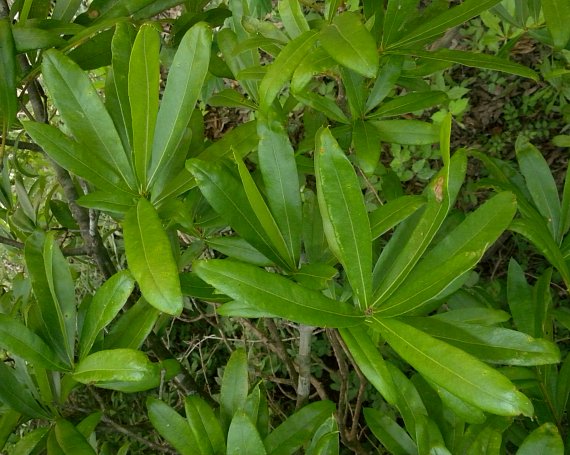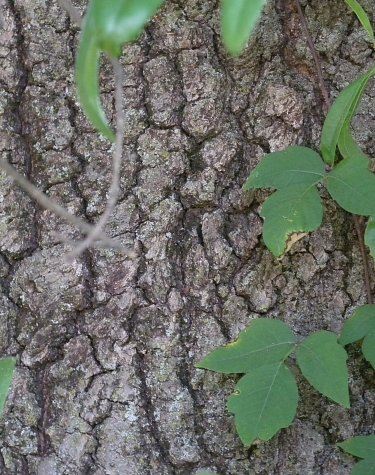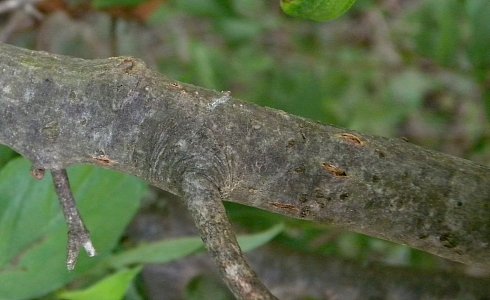
Willow Oak is monoecious, producing separate male (staminate) and female (pistillate) flowers on the same tree. Male flowers are produced in drooping yellowish catkins about 2-3" long. The central stalks of these catkins are hairy. Each male flower consists of a campanulate (cup-shaped) calyx and several stamens; it is about 1/8" (3 mm.) long. The upper edge of the male calyx is rather jagged and hairy. Female flowers are produced in groups of 2-3 near the tips of twigs. Each female flower consists of a 3-lobed calyx that surrounds the ovary and 3 recurved styles; it is about 1/8" (3 mm.) long. The lobes of the female calyx are hairy. The blooming period occurs during mid-spring for about 1-2 weeks, shortly before the vernal leaves develop. The flowers are cross-pollinated by the wind. Afterwards, fertile female flowers develop into acorns. Because Willow Oak is a member of the Red Oak group, these acorns require 2 years to fully develop. At maturity during the late summer or fall of the 2nd year, these acorns are about 8-10 mm. (between ¼-½") long and similarly across. The shallow scaly cap extends to about one-fourth of the length of the acorn. The kernels of these acorns are yellow and somewhat bitter. Usually, this tree produces an abundant crop of acorns each year. The woody root system is shallow and spreading.

Cultivation: This tree prefers full sun, wet to moist conditions, a fertile soil containing loam or silt, and some decaying organic matter. An acidic soil is preferred (pH 4.5-5.5). While this tree readily tolerates flooded conditions during the winter and early spring, it prefers soil that is not waterlogged during the growing season (late spring and summer). Growth and development is moderately fast for an oak tree. While acorns can be produced in as little as 20 years, individual trees are often long-lived. Because of its branched root system, Willow Oak is easier to transplant than most oaks. This tree can be cultivated in areas that lie to the north of its natural range (to Zone 5 at least). It is susceptible to acid rain.

Range & Habitat: The native Willow Oak occurs in a few counties of southern Illinois, where it is uncommon and state-listed as 'threatened' (see Distribution Map). Illinois lies along the northern range limit of this tree. Habitats include floodplain woodlands, bottomland woodlands, moist woodland borders, drier areas of swamps, banks of streams, and low areas along lakes. Willow Oak is more tolerant of standing water than Cherrybark Oak (Quercus pagoda), but it is less tolerant of standing water than Overcup Oak (Quercus lyrata), and so it tends to occupy habitats that are intermediate between these 2 latter species. Because of its relatively thin bark and shallow root system, Willow Oak is vulnerable to wildfires, although such wildfires are uncommon in the soggy habitats that this tree prefers. Willow Oak is cultivated as a landscape tree, especially in the southeastern United States.

Faunal Associations: Willow Oak and other oak trees (Quercus spp.) function as keystone species in ecological systems because of the abundant sources of food and shelter that they provide. Many insects feed on the leaves, plant juices, wood, etc. of these trees. This includes larvae of wood-boring beetles, leaf beetles, weevils, larvae of gall flies, plant bugs, stink bugs, aphids, leafhoppers, treehoppers, armored scales, mealy bugs, larvae of gall wasps, larvae of sawflies, larvae of Hairstreak butterflies (Satyrium spp.), larvae of Duskywing skippers (Erynnis spp.), and larvae of many moths (see the Beetle Table, Aphid Table, Moth Table, and Miscellaneous Insect Table for more information). The large number of insects that feed on these trees attracts many insectivorous birds. The acorns of oak trees are a source of food to many kinds of birds and mammals. Birds that feed on acorns include ducks, blackbirds, woodpeckers, wild turkeys, blue jays, and crows (see Bird Table for more information). Mammals that feed on acorns include the Gray Fox, White-tailed Deer, White-footed Mouse, Virginia Opossum, Raccoon, Eastern Gray Squirrel, Fox Squirrel, Eastern Chipmunk, Muskrat (minor), and American Black Bear. White-tailed Deer and Elk also browse on the twigs and leaves, while the American Beaver gnaws on the wood and bark when these trees grow near bodies of water (Martin et al., 1951/1961; Hamerstrom & Blake, 1939; Beeman & Pelton, 1980; Schneider et al., 2006). Tree squirrels and bluejays, in particular, spread the acorns to new areas. Willow Oak and other oak trees provide considerable protective cover for various kinds of wildlife. Hawks, warblers, and woodland songbirds often construct their nests among the branches of these trees, while various species of bats select oak trees as daytime roost sites and locations for maternity colonies (Dijak et al., 1990; Newell & Rodewald, 2011; Bielefeldt & Rosenfeld, 2001; Best, 1978; Perry et al., 2010; Perry & Thill, 2008; Swier, 2003; Baerwald et al., 2012; Veilleux et al., 2003; Carter, 2003).

Photographic Location: Edge of a bottomland woodland in southern Illinois.
Comments: Willow Oak is readily identified by its narrow unlobed leaves that are 5-8 times as long as they are across. The only other oak in Illinois with similar unlobed leaves, Shingle Oak (Quercus imbricaria), prefers drier habitats and its wider leaves are about 3-4 times as long as they are across. Occasionally Willow Oak will hybridize with other species in the Red Oak group, resulting in trees that can be difficult to identify. Such hybrid trees tend to have somewhat narrow leaves with irregular shallow lobes. The leaves of Willow Oak superficially resemble those of willows (Salix spp.), such as Black Willow (Salix nigra), but the larger willows that become trees have leaves with serrated margins. In addition, the leaf tips of Willow Oak often have short bristles that the leaves of willows lack. The wood of Willow Oak is durable, somewhat soft, finely grained, and pale reddish brown. It has been used to make paper pulp, lumber for general construction, church pews, bar tops, railings, stairways, and furniture.